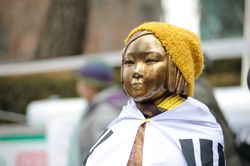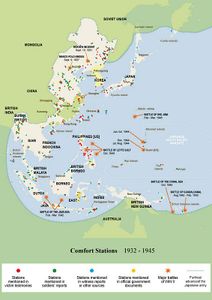"The Comfort Women Issue and Finding the Truth"의 두 판 사이의 차이
| (같은 사용자의 중간 판 3개는 보이지 않습니다) | |||
| 2번째 줄: | 2번째 줄: | ||
|Article=위안부 문제의 진실 | |Article=위안부 문제의 진실 | ||
}} | }} | ||
| − | |||
| − | |||
In 1937 during the [[Second Sino-Japanese War]], Japanese soldiers massacred and raped hundreds of thousands of the citizens of Nanjing City, the capital of the Republic of China. Considering the negative propaganda consequences, the Japanese government decided to establish "comfort stations" for the sexual service of its soldiers in territory that they occupied. | In 1937 during the [[Second Sino-Japanese War]], Japanese soldiers massacred and raped hundreds of thousands of the citizens of Nanjing City, the capital of the Republic of China. Considering the negative propaganda consequences, the Japanese government decided to establish "comfort stations" for the sexual service of its soldiers in territory that they occupied. | ||
| 11번째 줄: | 9번째 줄: | ||
The [[comfort women]] issue came to the surface in 1991 through the testimony of [[Kim Hak-sun]], a surviving victim. Later, 239 others living in Korea revealed that they were also victims. The Korean Council for the Women Drafted for Military Sexual Slavery by Japan was established to seek an apology and reparation from Japan, and still holds a demonstration at the Japanese Embassy every Wednesday. | The [[comfort women]] issue came to the surface in 1991 through the testimony of [[Kim Hak-sun]], a surviving victim. Later, 239 others living in Korea revealed that they were also victims. The Korean Council for the Women Drafted for Military Sexual Slavery by Japan was established to seek an apology and reparation from Japan, and still holds a demonstration at the Japanese Embassy every Wednesday. | ||
| − | [[파일:2-11.소녀상-FSC 5840.jpg|thumb|250px|right| | + | [[파일:2-11.소녀상-FSC 5840.jpg|thumb|250px|right|Statue of Peace in front of the Japanese Embassy in Seoul]] |
Japan claims that the imperial government was not involved in drafting the girls, as that was done by private contractors, and can make no official governmental apology or compensation. However, recent testimonies by Japanese soldiers and discovery of documentary evidence of the comfort stations has put pressure on Japan to take more responsibility. | Japan claims that the imperial government was not involved in drafting the girls, as that was done by private contractors, and can make no official governmental apology or compensation. However, recent testimonies by Japanese soldiers and discovery of documentary evidence of the comfort stations has put pressure on Japan to take more responsibility. | ||
In 2015, Korea (under President [[Park Geun-hye]]) and Japan made a secret agreement to compensate the victims through a private organization. But the Korean public strongly protested having the issue resolved though a "deal," rather than through Japan's acknowledgement of its crimes and an apology. Korea's new President [[Moon Jae-in]] has told Japan that Koreans find the deal unacceptable and offered to reopen talks on the issue. As of June 2017, 38 former Korean [[comfort women]] remain alive. Statues of a young girl memorializing the victims has been set up in many locations in Korea and overseas. | In 2015, Korea (under President [[Park Geun-hye]]) and Japan made a secret agreement to compensate the victims through a private organization. But the Korean public strongly protested having the issue resolved though a "deal," rather than through Japan's acknowledgement of its crimes and an apology. Korea's new President [[Moon Jae-in]] has told Japan that Koreans find the deal unacceptable and offered to reopen talks on the issue. As of June 2017, 38 former Korean [[comfort women]] remain alive. Statues of a young girl memorializing the victims has been set up in many locations in Korea and overseas. | ||
| − | == | + | <gallery mode=packed heights=200px> |
| − | < | + | File:017(E).jpg|Comfort Stations |
| + | </gallery> | ||
=='''Related Articles'''== | =='''Related Articles'''== | ||
| 27번째 줄: | 26번째 줄: | ||
*[[Moon Jae-in]] | *[[Moon Jae-in]] | ||
| + | =='''References'''== | ||
| + | <references/> | ||
[[분류:Debates on Korea]] | [[분류:Debates on Korea]] | ||
2017년 11월 23일 (목) 09:49 기준 최신판
In 1937 during the Second Sino-Japanese War, Japanese soldiers massacred and raped hundreds of thousands of the citizens of Nanjing City, the capital of the Republic of China. Considering the negative propaganda consequences, the Japanese government decided to establish "comfort stations" for the sexual service of its soldiers in territory that they occupied.
The "comfort women" who served at these stations were mostly abducted from Korea, the Philippines, China and Indonesia. The majority were Korean girls between the ages of 16 and 20; The total number drafted is estimated at a theoretical maximum of 200,000. Many were poor girls lured by false offers of jobs. As the Pacific War spread and demand increased, some girls were violently kidnapped and forced to serve as sex slaves for the Japanese soldiers.
Upon losing the war, the Japanese government tried to hide the existence of the comfort women by killing or abandoning those who remained. Some managed to return home but suffered from disease and the contempt of society.
The comfort women issue came to the surface in 1991 through the testimony of Kim Hak-sun, a surviving victim. Later, 239 others living in Korea revealed that they were also victims. The Korean Council for the Women Drafted for Military Sexual Slavery by Japan was established to seek an apology and reparation from Japan, and still holds a demonstration at the Japanese Embassy every Wednesday.
Japan claims that the imperial government was not involved in drafting the girls, as that was done by private contractors, and can make no official governmental apology or compensation. However, recent testimonies by Japanese soldiers and discovery of documentary evidence of the comfort stations has put pressure on Japan to take more responsibility.
In 2015, Korea (under President Park Geun-hye) and Japan made a secret agreement to compensate the victims through a private organization. But the Korean public strongly protested having the issue resolved though a "deal," rather than through Japan's acknowledgement of its crimes and an apology. Korea's new President Moon Jae-in has told Japan that Koreans find the deal unacceptable and offered to reopen talks on the issue. As of June 2017, 38 former Korean comfort women remain alive. Statues of a young girl memorializing the victims has been set up in many locations in Korea and overseas.

